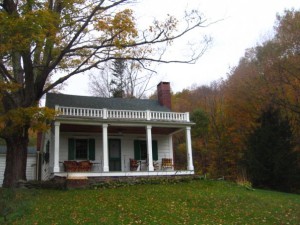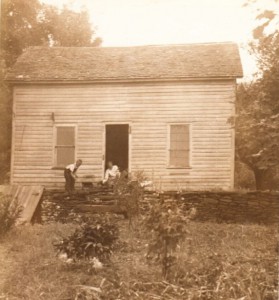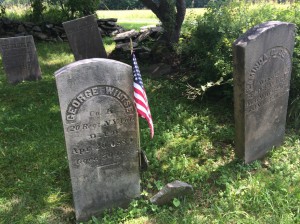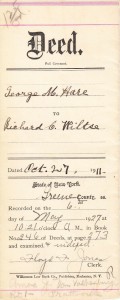I spent my childhood at our family home in the Catskill Mountains in New York. My roots in the Catskills date back to the mid-eighteenth-century, when the first of the Holdridge line of my family appeared in the area. As far as we can tell, the Holdridges came from Connecticut, settling first in Columbia County, New York, before finally establishing a line spanning many generations in Greene County. While my mother’s family has lived in these mountains for two centuries, it was my father’s family home, which we lovingly refer to as “The Farm,” where I still spend many lazy days of summer. It is a special place for me which connects numerous points of my ancestry.
The Heisingers are far more recent additions to the Catskills. Walter and Anna Heisinger (my father’s grandparents) purchased the house from the Van Valkenburgh family in 1937 to use as a summer home. At that time my grandfather, Walter “Bob” Heisinger, was about 10 years old. The Van Valkenburghs also had a boy about the same age named Philip. We have a number of photographs of both of them as little boys at the Farm. Oddly enough, Bob and Philip’s sons both married Kiley women. My father married my mother, and Philip’s son married my mother’s sister. For this reason, my cousins are Van Valkenburghs who also spent much of their childhoods at the Farm. We often joke that we kept the house in the family, since my great-grandparents purchased the house from their great-grandparents.
My cousins and I were strange children, interested at an early age in the history and people of the region. At the bottom of our driveway is a small cemetery with only fourteen known interments, almost all of which are for the Shoemaker and Wiltse families. As children we would make our annual trip down the quarter-mile path carrying a bucket of soapy water and some scissors. We would spend an afternoon cleaning the stones and cutting the grass to make sure the names were visible. We often imagined the lives of the people who managed our land long before us and assigned them relationships and personalities based on what we could glean from the grave makers. Over the years, the individuals in this plot became adopted members of our family and I still go down to be sure the cemetery is looked after.
As I grew up, I became more interested in finding out more about the real lives of the individuals buried in the Shoemaker/Wiltse Cemetery. Some things we could discern just by looking at the stones. We knew that George Wiltse was in the 120th New York during the Civil War and that his wife was Laminda C. Deming. My father, the Civil War buff, then informed the family that George Wiltse served in the Battle of Gettysburg. The only United States flag in the cemetery marks his service. Beyond this we did not know much about the individuals buried here. We were also not certain if all or only some of them lived on our property.
To find out more about them, I started by searching the 1855 New York States Census and found George Wiltse/Wiltsey as a nineteen-year-old living in the household of his parents, Samuel and Mariah. They are listed directly next to the household of William Shoemaker and a number of familiar names from the cemetery. One of the first things that struck me about the record was that Samuel Wiltsey and William Shoemaker were born in Columbia County. Even more striking to me was the fact that William Shoemaker’s wife, Mary, was born in Connecticut. At first glance, it appeared that these two families made a similar migration to the area as my Holdridge family. Perhaps further research will reveal if they took the same path and even if they knew each other.
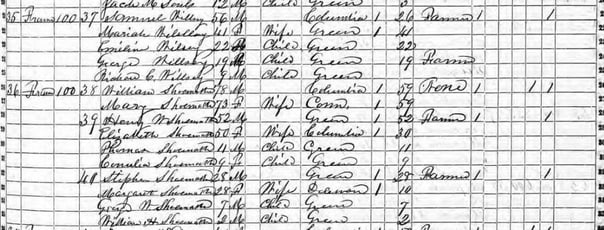 Prattsville, Greene County, New York. Census of the state of New York, for 1855. Microfilm. New York State Archives, Albany, New York.
Prattsville, Greene County, New York. Census of the state of New York, for 1855. Microfilm. New York State Archives, Albany, New York.
From the 1855 New York State Census, I was able to determine that the Wiltse and Shoemaker families were neighbors, both living in the area of our property at the same time. My next question was: Which one of these families lived at The Farm? During my last visit home, my dad presented me with a box he uncovered containing various documents relating to the property. Included in the box were a number of original deeds.
Flipping through the papers, one name immediately stuck out: Wiltse. The oldest deed in the box is dated 1911, which states that Richard C. Wiltse purchased the property from a George M. Hare. This was a name I had never heard before, and I knew that there were not any individuals with the surname Hare buried in the plot at the bottom of our road. My new quest is to locate earlier deeds and maps to determine who lived in our house and how the property was transferred. It always seems that answers will generate at least twice as many new questions on which to reflect.
Share this:
About Meaghan E.H. Siekman
Meaghan holds a Ph.D. in history from Arizona State University where her focus was public history and American Indian history. She earned her B.A. in history from Union College in Schenectady, New York, the city where she grew up. Prior to joining the NEHGS team, Meaghan worked as the Curator of the Fairbanks House in Dedham, Massachusetts, as an archivist at the Heard Museum Library in Phoenix, Arizona, and wrote a number of National Register Nominations and Cultural Landscape Inventories for the National Park Service. Meaghan is passionate about connecting people with the past in meaningful and lasting ways. She enjoys finding interesting anecdotes about an ancestor to help bring the past to life.View all posts by Meaghan E.H. Siekman →
